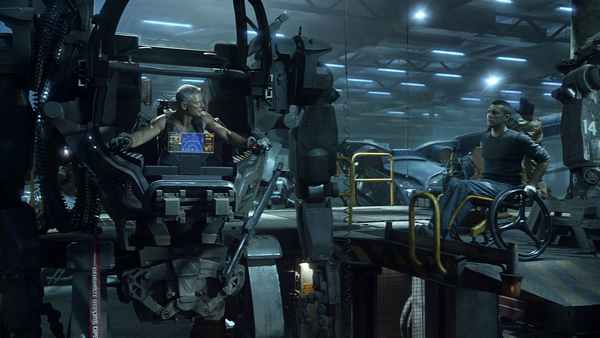Silhouette is a revolutionary rotoscoping, paint, keying and visual effects suite utilized by top visual effects facilities around the world. All Silhouette capabilities, including its award-winning roto and paint components, as well as its keying, effects and compositing features, are stereo enabled.
We discussed with Marco Paolini who is the President of Digital Film Tools the latest release of SilhouetteFX.
Q. Tell us a little bit about SilhouetteFX.
Marco Paolini: Our understanding of visual effects allows us to design productive and highly specialized software. Our products were born in the trenches of production and are the culmination of many years of experience. Add an Academy Award for Scientific and Technical Achievement, 3 Emmy Awards, and experience in creating visual effects for hundreds of feature films, commercials, and television shows and we think you have a combination that can’t be beat.
Q. What exactly is Silhouette, how does it work and who is the ideal user?
Marco Paolini: Silhouette is a revolutionary rotoscoping, paint, keying and visual effects suite utilized by top motion picture filmmakers and cinematgraphers around the world. All Silhouette capabilities, including its award winning roto and paint components, as well as its new keying, effects and compositing features, are stereo enabled.
Q. Can you tell our reader more about features like Roto, Tracking, Paint, Keying and stereoscopic workflow?
Marco Paolini: Silhouette allows you to quickly create sophisticated animated mattes using B-Spline, Bézier or X-Spline shapes. Intelligent design and easy-to-use tools, such as variable edge softness on a point by point basis and realistic motion blur, assist you in creating complicated shape animations. Integrated motion tracking makes the normally tedious task of rotoscoping a breeze.
In Silhouette, images can be tracked using an automatic image tracking system called Planar tracking, or Point tracking which utilizes either one, two or four track points. One point tracking obtains horizontal and vertical movement. Two point tracking analyzes scaling and rotation in addition to horizontal and vertical movement. Lastly, four point tracking evaluates and applies perspective movement using a corner-pin transformation. However the tracking data is obtained, it can then be applied in one of two ways: match moving or stabilization. Match moving applies the motion of the trackers to a layer so that it’s shapes follow the motion of the clip. Stabilization inverts the tracking data so that the clip appears to be stable.
Paint is a high dynamic range 2D raster based paint system designed from the ground up to handle the demands of feature film and television production. Whether it’s image restoration, dustbusting, wire and rig removal or just plain paint, Silhouette provides simple and sensible tools to get the job done.
Using proprietary matte extraction techniques, Silhouette’s Keyer and Power Matte modules are capable of extracting almost any object in an image quickly and simply even if you are dealing with fine hair detail, smoke, or reflections. They are easy to use, yet provide the needed tools when faced with good, bad, or ugly shots.
All of our tools are stereo enabled making the 2d-3d conversion process less painful.
Q. What inspired you to create Silhouette?
Marco Paolini:In our past lives of creating visual effects, we were always looking for a faster, better way to extract and isolate objects. This led to us developing a dedicated tool that tackle that task. Rotoscoping is tedisu, ugly work, but is one of the most important parts of the visual effects process. Save time in rotoscoping and you save time in the rest of the effects process.
Q. What applications does Silhouette work with?
Marco Paolini:Silhouette can export Autodesk®/Discreet® gMask, Elastic Reality®, Eyeon Fusion®, Nuke® and Shake® 4.x SSF shapes as well as import Commotion, Elastic Reality and Shake 4.x SSF shapes.
We interchange masks with After Effects® using the free Silhouette Shape Import/Export Plug-in.
We export After Effects, Autodesk/Discreet, Nuke and Shake 4.x trackers as well as import After Effects Corner-Pin, Nuke and Shake 4.x trackers.
Q. Are there any references or examples where Silhouette has been used in production?
Marco Paolini: Most of our customers are tight lipped about what software they use in their movies. Several high profile customers have even made us sign non-disclosure agreements that requires us to disavow their use of Silhouette. Most of the high profile movies out there have had Silhouette touch their frames.
Q. What are potential uses of Silhouette that have not been realized?
Marco Paolini: I think Silhouette is being used as it is meant to be used–hard core roto, keying and paint.
Q. When should your customers use the latest version 4.5 instead of earlier version like 4.3?
Marco Paolini: Because Silhouette v4.3.3’s paint projects are not compatible with 4.5, we recommend that you use 4.5 on new projects. Silhouette v4.5 will install in it’s own folder allowing you use either v4.3.3 or v4.5. This will enable you to continue to open and work on older paint projects if you need to.
Q. What are the future plans for Silhouette?
Marco Paolini: I am sorry, it is our policy to not divulge future plans. I can say that we have some exciting new features in store for Silhouette v5.
Q. What are the biggest pain points that creative professionals are facing in their daily work?
Marco Paolini: Facilities must deal with color space issues on every show–and it’s not getting any easier. Color Management is one of the trickiest and most challenging aspects of digital motion-picture production. This is particularly true of visual effects and animation, where images often flow through multiple software applications and production houses, each often using their unique color processes. Virtually every facility must re-invent a color workflow, for every application – which is hard to get right. OpenColorIO, now included in Silhouette v4.5, addresses this critical issue.
OpenColorIO (OCIO), originally developed by Sony Pictures Imageworks for its color management, enables color transforms and image display to be handled in a consistent manner across multiple graphics applications. Unlike other color management solutions, OCIO is geared towards motion-picture post production, with an emphasis on visual effects and animation color pipelines. By providing a unified color environment, OpenColorIO greatly simplifies the task of creating and validating multiple-application color workflows.
Q. Tell us a little about your customers and how they use Silhouette to address the most pressing pain points?
Marco Paolini:For smaller facilities, OpenColorIO allows artists to work in a properly color-managed process with minimal effort. For larger facilities, off-the-shelf OCIO-compatible tools can be extensively customized — matching existing facility color practice.
You can load custom color configuration files and custom LUTs, apply colorspace conversions, as well as use other controls for fine tuning. Silhouette includes a set of preset color profiles, plus you can configure and use your own.






